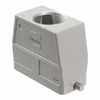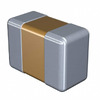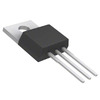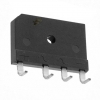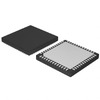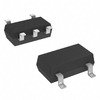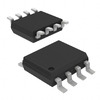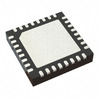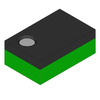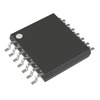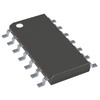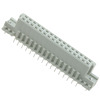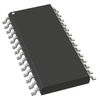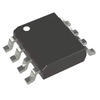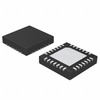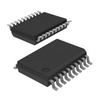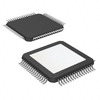Differential Amplifiers Explained: Building and Optimizing Precision Signal Circuits
This guide talks about differential amplifiers, special circuits that help pick up the difference between two signals while ignoring any noise that both signals share. It explains how differential amplifiers work, how they are built using operational amplifiers (op-amps), and how resistors control how much the signal gets amplified. It also shows how to handle weak signals by adding buffers, how to design the circuit properly, and how to use these amplifiers like comparators and automatic light switches. Whether you're working with sensors, audio systems, or control circuits, this guide gives you a clear and simple understanding of why differential amplifiers are so important and how to use them.Catalog

What is a Differential Amplifier?
A differential amplifier is a core part of many analog systems. Its main function is to amplify the voltage difference between two input signals while ignoring any voltage that is common to both. This selective amplification is what makes it so useful in noisy environments. When interference like electromagnetic noise or power line hum affects both inputs equally, the amplifier effectively cancels it out.
This ability is called common-mode rejection. A high common-mode rejection ratio (CMRR) ensures the amplifier focuses only on the true signal difference, which helps preserve accuracy. For example, in medical equipment like ECG machines, the heart's electrical signals are tiny and often buried in noise. A differential amplifier extracts these signals cleanly, allowing for reliable readings. The same principle applies in industrial or audio systems, where precision and resistance to noise are important.
When signals travel long distances, such as through twisted-pair cables in data acquisition systems, both wires pick up similar interference. The differential amplifier cancels this shared noise and amplifies only the useful signal difference. Because of this, it’s a key component in precision electronics used in everything from sensor interfaces to high-fidelity audio.
Op-Amps in Differential Amplification
An op-amp, short for operational amplifier, is an electronic part that can make small voltage signals much bigger. It has two input pins: one is called the non-inverting input (marked with a “+”), and the other is the inverting input (marked with a “−”). The op-amp compares the voltages at these two inputs and gives an output based on the difference between them. By itself, an op-amp has a very high gain, which means even a tiny voltage difference between the two inputs can push the output to its maximum or minimum level. This makes it too sensitive for most uses. To fix this, we add something called negative feedback, this is when part of the output is sent back into the inverting input through resistors. This helps the op-amp keep the output at a steady and useful level. The resistors control how much the op-amp amplifies the difference between the two inputs.

Figure 2. Op-Amps in Differential Amplification
The figure shows a special setup called a differential amplifier, sometimes called a diff amp for short. It uses four resistors (R₁, R₂, R₃, and R₄) and two input signals: V₁ and V₂. The op-amp looks at how different V₁ and V₂ are and gives an output voltage V₀ that is based on that difference. This kind of circuit is great at picking up the difference between two signals while ignoring any noise or unwanted signals that are the same on both inputs. That’s why it’s used in things like sensor circuits, audio systems, and measurement tools where you need clear and accurate signals.
Building a Differential Amplifier with a Set Gain
Circuit Design
To make a differential amplifier that works in a clear and reliable way, use a balanced setup with four resistors. The diagram shows how this is done using an op-amp (operational amplifier), two input voltages (V₁ and V₂), and four resistors: R1, R2, R3, and R4.

Figure 3. Differential Amplifier Circuit with Symmetrical Resistor Network
In this circuit, the first input voltage, V₁, is sent through resistor R1 to the inverting input of the op-amp (marked with a minus sign). The second input voltage, V₂, goes through resistor R3 to the non-inverting input (marked with a plus sign). Then, resistor R2 connects the inverting input to the ground, and resistor R4 connects the op-amp’s output back to the inverting input. This feedback loop helps the op-amp control the output and keep the difference between the two inputs steady.
The main idea of this amplifier is to measure the difference between V₂ and V₁ and multiply that difference by a certain amount, this is called the gain. The gain is set by choosing the right resistor values. If R1 and R3 have the same value, and R2 and R4 also have the same value, the circuit will work well and give a clean, accurate output. Having equal resistors is very important. When the resistors are matched, the circuit can ignore any noise or interference that is the same on both input lines. This is called common-mode rejection, and it helps keep the output signal clean. If the resistors aren’t matched well, the circuit might let unwanted signals through, which can mess up the output.
To avoid this, use high-precision resistors that are very close in value, often within 0.1% of each other. In more advanced designs, like the ones found inside microchips, the resistor values are carefully adjusted using laser trimming to make sure everything is balanced. In other cases, also think about temperature, because heat can change how resistors behave. So, they try to choose resistors that aren’t affected much by temperature or arrange them in a way that keeps things stable. This simple type of differential amplifier is often used as the starting point for more complex systems, such as instrumentation amplifiers. Those circuits use extra parts to improve performance even more, especially when working with very small signals in noisy environments.
Calculating Gain
The gain of a differential amplifier is a measure of how much the circuit increases the difference between the two input voltages, V₁ and V₂. In other words, gain tells us how much bigger the output will be compared to the difference between the input signals. This gain is set by the resistors in the circuit specifically, by comparing the values of the input resistors and the feedback resistors. If we set the resistors in a balanced way, calculating the gain becomes very simple. Let’s say R1 is the same as R3, and R2 is the same as R4. This kind of setup is called symmetrical, and it helps the circuit work more accurately. In this case, the formula for the gain of the amplifier looks like this:

This formula means that the amplifier takes the difference between V₂ and V₁ and multiplies it by the number you get when you divide R2 by R1. So if R2 is twice as big as R1, the output will be two times the difference between V₂ and V₁.
Here’s an example:
If V₂ = 3 volts and V₁ = 1 volt, the difference is 2 volts.
If R2 is 10kΩ and R1 is 5kΩ, then the gain is 10k / 5k = 2.
So the output voltage will be 2 × 2 = 4 volts.
If you make all four resistors the same (R1 = R2 = R3 = R4), the gain becomes 1. That means the amplifier doesn’t change the size of the difference, it just passes the difference to the output as it is. This is useful when you just want to measure or pass along a signal without making it stronger. Sometimes, though, you need the output to be stronger, especially if the input signals are very small. To do this, you can make R2 and R4 bigger than R1 and R3. This increases the gain, and makes the output signal larger. For example, if R2 is ten times bigger than R1, the gain is 10, and the output is ten times the input difference.
But increasing gain also has downsides. A high gain can also make unwanted signals, like noise or interference, stronger. It might even make tiny voltage errors look big. This can make the amplifier’s output noisy or inaccurate. So it's important to choose the resistor values carefully, so the gain is high enough to see the signal clearly, but not so high that it causes problems. Also, op-amps aren’t perfect. They can have small built-in errors that change how the circuit works. For example, the op-amp might produce a small output even when the inputs are exactly the same. This is called offset voltage. Another common issue is bias current, which is a tiny current that flows into the input pins and can change voltages slightly. To fix or reduce these problems, adjust the circuit after building it (called trimming), add extra components to cancel out errors (offset nulling), or use special op-amps that are designed to be very accurate and stable. .
Input Impedance and Buffering
A basic differential amplifier is a simple and useful circuit. It increases (amplifies) the difference between two input voltages and ignores anything that is the same on both. But this simple design has a problem when it connects to weak or high-impedance signal sources (like some sensors). The issue comes from the inverting input of the amplifier. Because of how the circuit works, this input acts like a virtual ground, which means it can pull current from the signal source.
If the signal source can't give much current like some sensors or delicate circuits, this can change the signal. The signal may get smaller (weaker) or distorted, which means the amplifier gives a wrong result. To fix this, use voltage followers, also called buffer amplifiers, at each input. These are special amplifier circuits that don’t increase the voltage, but they have a very high input impedance and a low output impedance. That means they don’t draw much current from the signal source, so the signal stays the same. The buffer just passes the signal along without changing it. When you add these voltage followers to the differential amplifier, you get a better circuit called a three-op-amp instrumentation amplifier. This new version has a very high input impedance, so it works well with weak signals.
You can also set the gain (how much the signal is amplified) using external resistors. It also blocks noise well and gives a clean, accurate signal. These improved amplifiers are used in precise jobs, like reading tiny signals from thermistors, strain gauges, or medical sensors. These signals are often very small (like microvolts) and need to be amplified clearly, even in noisy places. To make sure the amplifier works at its best, the physical design of the circuit is also important. Many use special layout tricks, like shielding parts of the circuit to block unwanted signals and keeping wires short to avoid problems with unwanted capacitance. This helps the amplifier work well even with very small or fast signals.

Figure 4. Three-Op-Amp Instrumentation Amplifier with Input Buffers
The figure displays a three-op-amp instrumentation amplifier. The first two op-amps act as buffers, receiving the input signals V1 and V2 and forwarding them without drawing current from the sources. These buffered signals then pass through resistors and converge at the third op-amp, which serves as a differential amplifier. This final stage subtracts one input from the other to produce the output voltage Vout. This configuration enhances signal integrity and is well-suited for handling weak or sensitive signals safely.
Differential Amplifiers Applications
Comparators
In some circuits, we use a type of amplifier called a differential amplifier without any feedback. When we do this, it becomes a comparator. A comparator is a device that quickly checks which of two voltages is bigger. Once it makes the comparison, it changes its output to either a high or low voltage, almost like a simple switch. This kind of on-or-off behavior is very useful in digital systems and automatic control circuits. One example is a zero-crossing detector. It watches an AC (alternating current) signal and changes its output whenever the signal goes through zero volts. This is helpful in timing and controlling things that depend on the phase of the signal.
Comparators are also important in devices called analog-to-digital converters (ADCs). These converters change signals (like sound or temperature) into digital numbers that computers can understand. The comparator helps by comparing the changing signal to a fixed reference voltage. Even though regular op-amps (operational amplifiers) can work as comparators in simple circuits, there are special comparator chips made just for this job. These special chips are faster and more accurate. They may also include extra features, such as hysteresis (which helps avoid switching too often because of small changes or noise) and open-collector outputs (which make it easier to connect to digital circuits).

Figure 5. Comparator Circuit Using a Wheatstone Bridge Configuration
The figure illustrates a comparator circuit with a classic Wheatstone bridge configuration. Four equal resistors R form the bridge network, creating a balanced condition when all components are symmetrical and the input is at 0 volts. The voltages from the bridge arms, labeled V1 and V2, are fed into the inverting and non-inverting inputs of a comparator, respectively. Under balanced conditions, V1 and V2 are equal, resulting in a zero output. Any imbalance in the bridge such as a change in one resistor due to temperature or strain, will produce a voltage difference between V1 and V2, causing the comparator to switch its output accordingly.
Light-Sensitive Switches
Light-sensitive switches are applications of differential amplifiers that enable automatic control of electrical devices in response to varying ambient light levels. These circuits commonly use a Light Dependent Resistor (LDR), a component whose resistance changes based on the intensity of light falling on it. By integrating an LDR into a voltage divider network, it becomes possible to convert light intensity into a corresponding voltage signal. The core operation of such a switch relies on a differential amplifier, which receives two inputs: one from the voltage divider containing the LDR and the other from a reference voltage. The reference voltage can be made adjustable using a variable resistor (VR1) or potentiometer. This configuration enables to precisely set the light intensity threshold at which the switch will activate or deactivate the connected load.
As ambient light changes, the resistance of the LDR varies, altering the voltage at one input of the differential amplifier. When this input voltage surpasses or falls below the reference voltage, the output of the amplifier toggles. This output is used to drive a transistor switch, which in turn activates a connected device such as a lamp, relay, or fan. The inclusion of a feedback resistor (Rf) improves the stability and responsiveness of the amplifier circuit. Meanwhile, the transistor stage, often paired with a flyback diode (D1), provides the necessary current amplification and protects against voltage spikes when inductive loads like relays are used.

Figure 6. Light-Sensitive Switch Using a Differential Amplifier and LDR
The figure illustrates a light-sensitive switch circuit based on a differential amplifier. A Light Dependent Resistor (LDR) and a fixed resistor (R1) form a voltage divider that provides a variable voltage input (V1) to the inverting terminal of the operational amplifier. The non-inverting input receives a reference voltage (V2), set using a variable resistor (VR1) in series with resistor R2. The differential amplifier compares these inputs, with its output connected to the base of a transistor through a resistor (R3). When the light intensity changes such that V1 crosses the threshold set by V2, the amplifier output switches states, turning the transistor on or off. This, in turn, controls a connected relay coil, indicated in the diagram with an output connection. A diode (D1) is placed in parallel with the relay coil to protect against voltage spikes. Resistor R4 serves as a pull-down for the transistor's base. The overall circuit enables automatic switching based on ambient light conditions.
Advantages of Differential Amplifiers
• Excellent Noise Rejection: Differential amplifiers are designed to amplify the difference between two input signals while ignoring any voltage that is common to both. This makes them highly effective at rejecting electromagnetic interference and noise that affects both input lines equally, a key benefit in environments with a lot of electrical noise, such as factories or near power lines.
• High Accuracy: These amplifiers offer excellent linearity, meaning the output is directly proportional to the input voltage difference with very little distortion. This makes them ideal for systems that require high precision, like audio equipment, data acquisition systems, or scientific instruments, where even small inaccuracies can compromise performance.
• Versatile Design: With simple modifications to their circuit configuration, differential amplifiers can be used in a variety of roles such as basic amplifiers, voltage comparators, voltage followers (buffers), or as building blocks in more advanced instrumentation systems. This flexibility makes them a popular choice in many analog designs.
• Improves Signal Quality Early: By amplifying the desired signal and rejecting noise early in the signal chain, differential amplifiers help ensure a clean signal is passed through the rest of the system. This reduces the need for complex filtering or digital correction downstream, saving processing power and improving overall system reliability.
• Reliable in Harsh Settings: Because of their noise-rejection and precision, differential amplifiers are widely used in high-stakes environments like aerospace systems, medical devices, and laboratory equipment. In these fields, accurate and stable measurements are important, and differential amplifiers help maintain signal integrity even under challenging conditions.
Conclusion
Differential amplifiers are important tools in electronics because they help you amplify the right signal and get rid of unwanted noise. They work by boosting the difference between two input voltages and ignoring anything that’s the same on both. You learned how op-amps are used to make these amplifiers and how matching resistor values is key to keeping the circuit accurate. We also explained how to increase the amplifier’s input resistance by using buffers, which helps when you're working with small or weak signals. These amplifiers can also be used as comparators and smart light switches, showing how useful and flexible they are. Knowing how they work helps you build better and more reliable circuits.
About us
ALLELCO LIMITED
Read more
Quick inquiry
Please send an inquiry, we will respond immediately.
Frequently Asked Questions [FAQ]
1. What is the basic structure of a differential amplifier?
A differential amplifier has an op-amp and four resistors. One input goes to the inverting terminal through a resistor, and the other input goes to the non-inverting terminal through another resistor. Two more resistors provide feedback and grounding. The circuit amplifies the voltage difference between the two inputs while ignoring any voltage common to both.
2. What are the disadvantages of a differential amplifier?
Its accuracy depends on how well the resistors are matched. If the resistor values are off, the amplifier may let noise through. It also struggles with high-impedance sources, which can cause signal loss or distortion. At high gain, even small internal errors like offset voltage or bias current can affect the output. Complex layouts and extra buffers may be needed for precision.
3. What are the two outputs of a differential amplifier?
Most basic differential amplifiers have one output that shows the amplified difference between two inputs. Some advanced versions, like fully differential amplifiers, have two outputs. These outputs are equal in amplitude but opposite in phase, making them useful in systems that need better noise immunity.
4. What are the main characteristics of a differential amplifier?
It amplifies the voltage difference between two inputs and rejects any voltage common to both. It has high common-mode rejection, good linearity, and adjustable gain through resistor values. With buffers, it can have high input impedance. It is reliable in noisy environments and works well with small signals from sensors or audio sources.
5. How to increase the gain of a differential amplifier?
You increase the gain by adjusting the resistor values. The gain equals the ratio of the feedback resistor to the input resistor, typically Gain = R2 / R1. Using larger feedback resistors or smaller input resistors raises the gain. However, high gain can also amplify noise or internal errors, so resistor values should be chosen carefully for a good balance between signal strength and accuracy.

Solving Electrical Circuits Using Mesh Currents
on May 2th

EPM570F256C5 CPLD: Features, Programming, Alternatives and Applications
on May 2th
Popular Posts
-

Understanding Power Supply Voltages in Electronics VCC, VDD, VEE, VSS, and GND
on June 13th 24175
-

USB-C Pinout and Features
on June 13th 21286
-

The Ultimate Guide to Wire Color Codes in Modern Electrical Systems
on January 1th 17465
-

TL494 Current-Mode PWM Controller IC
on January 1th 14733
-

Current Divider Circuits and Effective Use of the Divider Formula
on January 1th 13630
-

FET (Field Effect Transistor) Circuit Symbols
Field-Effect Transistors (FETs) are widely used in modern electronics and are found in everything from simple devices to complex digital systems. To work with these transistors effectively, it's helpful to understand the symbols that represent different types of FETs. These symbols do more than just show what the transistors look like—they also provide information about how each transistor works ...on January 1th 13440
-

Quality (Q) Factor: Equations and Applications
The quality factor, or 'Q', is important when checking how well inductors and resonators work in electronic systems that use radio frequencies (RF). 'Q' measures how well a circuit minimizes energy loss and impacts the range of frequencies the system can handle around its main frequency. In systems with inductors, capacitors, and tuned circuits, a higher 'Q' means the circuit focuses more on a spe...on January 1th 13393
-

Understanding and Building Op-Amp Based Peak Detectors
In the world of electronic circuit design, peak detectors are key tools for accurately analyzing and processing signal strengths. These circuits are designed to find and keep the highest signal amplitude, making sure the peak value is precisely captured and held as needed. Peak detectors are important in many fields, from improving audio quality in communication systems to aiding medical diagnoses...on June 13th 12497
-

LM741 Op-Amp: Features, Specifications, and Applications
The LM741 op-amp is a popular and flexible electronic component. This article goes over the pin layout, functions, specs, and different ways the LM741 can be used, while also comparing it to similar models like the LM358.Catalog1. What Is the LM741 Op-Amp?2. The LM741 Pin Configuration3. The LM741 Pin Functions4. Specifications of the LM7415. Features of LM7416. LM741 Circuit Applications7. LM741 ...on June 13th 12034
-

ST-LINK/V2: Pinout, Specifications, and Datasheet
This article takes you through the ST-LINK/V2, a well-regarded tool that amplifies connectivity and functionality. Key topics will cover its pinout configuration, delve into its 3D model, and spotlight specifications. Such understanding expands the horizons of STM microcontrollers in diverse applications. By grasping these interfaces and tools, you can transform embedded systems, opening doors to ...on January 1th 11579
